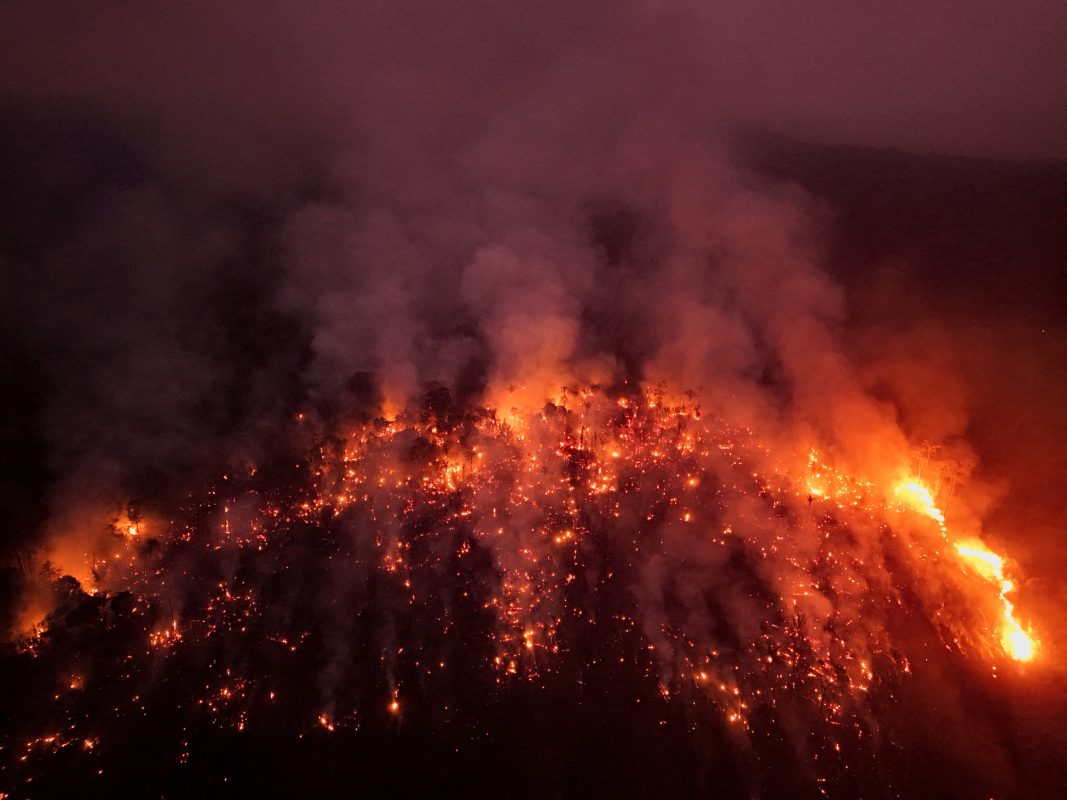Sugarcane farmer Marcos Meloni is still haunted by his battle last month to fight the flames on his land, as the double-edged disaster of fires and...
Vous n'êtes pas connecté
- English
- Français
- عربي
- Español
- Deutsch
- Português
- русский язык
- Català
- Italiano
- Nederlands, Vlaams
- Norsk
- فارسی
- বাংলা
- اردو
- Azərbaycan dili
- Bahasa Indonesia
- Հայերեն
- Ελληνικά
- Bosanski jezik
- українська мова
- Íslenska
- Türkmen, Түркмен
- Türkçe
- Shqip
- Eesti keel
- magyar
- Қазақ тілі
- Kalaallisut ; kalaallit oqaasii
- Lietuvių kalba
- Latviešu valoda
- македонски јазик
- Монгол
- Bahasa Melayu ; بهاس ملايو
- ဗမာစာ
- Slovenščina
- тоҷикӣ ; toğikī ; تاجیکی
- ไทย
- O'zbek ; Ўзбек ; أۇزبېك
- Tiếng Việt
- ភាសាខ្មែរ
- རྫོང་ཁ
- Soomaaliga ; af Soomaali
Rubriques :
 Maroc - EURASIAREVIEW.COM - A la une - 09/Sep 00:15
Maroc - EURASIAREVIEW.COM - A la une - 09/Sep 00:15
Out-Of-Control Wildfires Have Brazil Gasping For Air – OpEd
By Luiz Cesar Pimentel In 2024,Brazil has seenan alarming 80% increase in fires compared to the previous year. August has been the worst month so far, with fires spreading from the Pantanal and the Amazon to São Paulo. Under a thick layer of smoke, Brazilians watch in disbelief as the fires continue to grow. São Paulo, one of 10 states affected by smoke and soot from the Amazon by late August, found relief on Friday, August 23, when a cold front arrived. The temperature dropped by 12°C, bringing some hope of cleaner air. That same morning, at 10:30 AM, IPAM (the Amazon Environmental Research Institute) satellites noticed an unusual rise in smoke columns. Within 90 minutes, the number of fire hotspots in the state had skyrocketed from 25 to 1,886, surpassing even the Amazon’s total. This sudden spike reflects a troubling year, as land clearing for agriculture drives most of the fires. While authorities haven’t officially declared the fires to be arson, evidence strongly suggests it. Over half of the fires were in sugarcane fields, with 20% in pastures and 17% in other crops. Nearly 4,000 rural properties were affected across 144 municipalities, with 48 placed on high alert. São Paulo saw a record number of fires this August — seven times more than the same month in 2023. Experts don’t hesitate to attribute this to human activity. “Fires started in 50 municipalities at once. That means 99.9% of them were caused by people,” said National Civil Defense Secretary Wolnei Wolff. “It’s unnatural to have so many fires break out in such a short time. It’s like São Paulo’s own ‘Fire Day,’” added Ane Alencar, IPAM’s Science Director. Alencar compares August 23 to Brazil’s 2019 “Fire Day,” when ranchers and land grabbers organized mass fires in the Amazon, burning 1,457 areas simultaneously. The fires prepared land for farming and cattle while also challenging environmental regulators under then-Minister Ricardo Salles. “I monitor satellite images daily, and I’ve rarely seen Brazil covered in smoke like this. It’s almost impossible that these fires were natural,” says Marcelo Seluchi, a climatologist at INPE. Alencar adds, “Fire remains a key tool in Brazilian agriculture, used to renew pastures and clear biomass from deforestation, making way for crops or grazing land.” The fires tend to flare up between July and October, Brazil’s dry season, with 80% of fires occurring during this period. However, 2024 presents an extra threat. According to Brazil’s National Center for Monitoring and Alerts of Natural Disasters (CEMADEN), the country is experiencing its longest drought in central regions in 44 years. Over 70% of municipalities are dealing with some level of drought. The record-setting number of fires in São Paulo is echoed in other states. Minas Gerais saw the highest fire activity in 13 years, while Mato Grosso experienced a 260% increase compared to 2023. Fires doubled in the Cerrado region. “I’d say 95% of this is linked to human activity. Fires were once controlled for land preparation, but today’s hotter and drier conditions make them harder to manage, even when not intended to spread,” says José Marengo, a CEMADEN researcher. The Pantanal, one of the world’s largest wetlands, saw a 3,316% rise in fires in August, with 3,758 fires compared to just 110 in 2023. In the Amazon, over 50,000 fires have been recorded since the start of the year. These fires send smoke across the country, creating a vast corridor of haze. During “Fire Day” in 2019, São Paulo turned dark in the middle of the afternoon as smoke blotted out the sun. In August 2024, the smoke tinted the skies shades of orange and red across Brazil. Weak laws exacerbate Brazil’s situation If investigations confirm the fires in São Paulo were deliberate, the motives could range from defiance of environmental laws to political or economic messages. One thing is clear, though — such acts continue because of the impunity surrounding them. In August, Greenpeace Brazil released a report marking five years since the 2019 “Fire Day.” They examined 478 properties linked to coordinated burns and found that 65% of the areas had been sanctioned for violations, but only 10% for illegal fires. Fines for these environmental crimes totaled around 1.3 billion reais ($232.2 million), yet only 41,000 reais ($7,300) had been paid. Some of these properties even received over 200 million reais ($35.7 million) in rural credit. Despite this, no one has been arrested in five years. Spain offers a stark contrast. In 2006, after a rise in human-caused fires, Spain passed a law prohibiting the sale, reclassification, or use of burned land for 30 years. This led to a significant drop in arson driven by speculation. In Brazil, if banks stopped giving credit to rural properties involved in illegal burns, it could make a major difference. Brazil’s laws on fires are weak. While burning is technically illegal in forests and native vegetation, there are exceptions. Fires can be authorized for “specific cases” by environmental agencies, and controlled burns for agriculture are allowed in “exceptional cases.” This loophole has resulted in 25% of the country’s land — an area larger than Mexico — being destroyed by fire between 1985 and 2023. “In Brazil, we have two main laws for forest fires. The first punishes anyone who starts a fire with 2 to 4 years in prison, plus a fine, if it’s intentional, and 6 months to 1 year if it’s accidental,” explains criminal lawyer Enzo Fachini. “If a fire is set in crops, pastures, or forests, the sentence can be 4 to 8 years.” Despite these laws, little happens. “We’ll assess the damage with rural unions and offer support. Agribusiness is crucial to the state,” said São Paulo Governor Tarcísio de Freitas on the second “Fire Day.” The São Paulo Department of Agriculture estimates losses at $1 billion reais ($178.6 million). Six people were arrested for suspected criminal actions, and two firefighters died fighting the flames. The smoke that blanketed much of the country led to a 60% rise in emergency medical visits due to poor air quality, mostly affecting children and the elderly. Supreme Court Minister Flávio Dino ordered the Defense, Justice, and Environment Ministries to urgently mobilize resources to fight the fires in the Pantanal and Amazon. However, with a 78% rise in fires between January and August compared to 2023, the situation remains critical. “We haven’t even reached the worst part yet — September,” warned Alencar. The views expressed in this article are the author’s own and do not necessarily reflect Fair Observer’s editorial policy. About the author: Luiz Cesar Pimentel is the editor of the weekly magazine Istoé, the second largest in Brazil. He has worked in communications for 25 years, focusing on digital, strategy and transmedia storytelling. Luiz led the Brazilian operations of MySpace, Jovem Pan and R7. His career has seen him work as a reporter for Folha de S. Paulo, Carta Capital and TRIP magazine, as well as the manager of UOL and an international correspondent in Asia. Luiz has also written seven books in the area of communication. He holds postgraduate degrees in international journalism from the Poynter Institute in Florida and artificial intelligence for communication from the University of California, Berkeley. Source: This article was published by Fair Observer
Articles similaires
A continent ablaze: South America surpasses record for fires
SAO PAULO, (Reuters) – South America is being ravaged by fire from Brazil’s Amazon rainforest through the world’s largest wetlands to dry...
A continent ablaze: South America surpasses record for fires
SAO PAULO, (Reuters) – South America is being ravaged by fire from Brazil’s Amazon rainforest through the world’s largest wetlands to dry...
Smoke from Brazil fires clouds major cities, neighbouring countries
RIO DE JANEIRO: Smoke from intense wildfires in the Amazon rainforest and other parts of Brazil was choking major cities, like Sao Paulo and Rio de...
Muskoka Lakes’ fire chief sounds alarm over deadly fires
Ryan Murrell, fire chief for the Township of Muskoka Lakes, says taking 60 seconds out of your day on Sept. 28 could save your life. “Being...
Brazil faces worst drought in 70 years, fuelling wildfires across the country
Brazil is grappling with its most severe drought in over seven decades, affecting nearly 60% of the nation. This prolonged dryness has led to extreme...
Brazil faces worst drought in 70 years, fuelling wildfires across the country
Brazil is grappling with its most severe drought in over seven decades, affecting nearly 60% of the nation. This prolonged dryness has led to extreme...
Wildfires around Los Angeles blanket city in smoke
Out-of-control wildfires surrounding Los Angeles continued to grow Tuesday, forcing families to evacuate and blanketing the sky with choking...
Wildfires around Los Angeles blanket city in smoke
Out-of-control wildfires surrounding Los Angeles continued to grow Tuesday, forcing families to evacuate and blanketing the sky with choking...
Brazil’s Crackdown On X Represents A Dangerous Approach To Institutional Mistrust – OpEd
By Diogo Costa As democracies grapple with misinformation, Brazil’s hardline approach is seen by some as a potential model. The country has...
Les derniers communiqués
-
Adobe Brings Conversational AI to Trillions of PDFs with the New AI Assistant in Reader and Acrobat
Adobe - 21/02/2024
-
Laura Frigenti takes the Helm as Chief Executive Officer of the Global Partnership for Education
Global Partnership for Education - 05/12/2022




